
Izatha prasophyta is a moth of the family Oecophoridae. It is endemic to New Zealand, where it is known from the North Island, except Hawkes Bay or the Wairarapa. Larvae likely feed on rotting wood although larvae of this species have been reared on the fruiting body of the bracket fungus Bjerkandera adusta. Adults are on the wing from November to February.
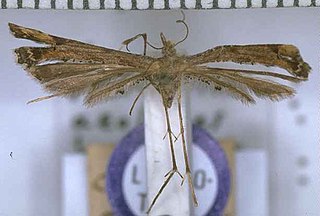
Amblyptilia aeolodes is a moth of the family Pterophoridae. This species was first described by Edward Meyrick in 1902. It is endemic to New Zealand and is found on the Chatham Islands, Big South Cape Island, and the subantarctic Auckland and Campbell Islands.The larvae feed on dicotyledonous herbs.

Amblyptilia epotis is a moth of the family Pterophoridae. It is endemic to New Zealand and is found in the South and Stewart Islands. It inhabits mountainous terrain covered in alpine vegetation or alternatively alpine wetland habitat. The adults of this species are on the wing from February to March. In appearance the adults of this species are variable in colour however this species can be distinguished from similar species by the oblique apical streak on its forewings as well as the patch of white on the costa cilia towards the apex of the forewing.

Pyroderces aellotricha, also known as the Cosmet moth, is a moth of the family Cosmopterigidae. It is found in New Zealand, in Australia and the Cook Islands.
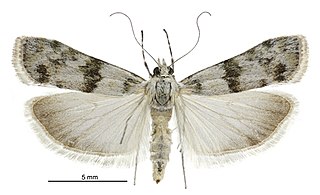
Eudonia asaleuta is a moth of the family Crambidae. It was described by Edward Meyrick in 1907. It is endemic to New Zealand and has been collected in the South Island in the West Coast, Fiordland,Canterbury, Otago and Southland regions. This species inhabits bare shingle areas as well as tussock habitat with few trees or scrub at altitudes of under 1000 m. Adults are on the wing from November to February.

Pyrgotis eudorana is a species of moth of the family Tortricidae. It is endemic in New Zealand and has been observed in both the North and South Islands. However it is regarded as a rare insect. This species inhabits native forest. Larvae exclusively feed on Muehlenbeckia australis and adults are on the wing from November to April. Adults are attracted to light.
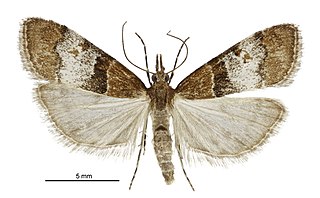
Antiscopa acompa is a moth in the family Crambidae. It was first described by Edward Meyrick in 1884. It is endemic to New Zealand and is found both the North and South Islands. The species inhabits native forest and adult moths are attracted to light.
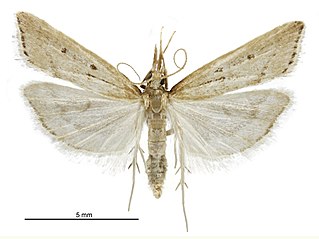
Antiscopa elaphra is a moth in the family Crambidae. It is endemic to New Zealand and has been observed in both the North and South Islands. Adults of this species are on the wing from August until March and are attracted to light. In 2020 this species had its DNA barcode sequenced.
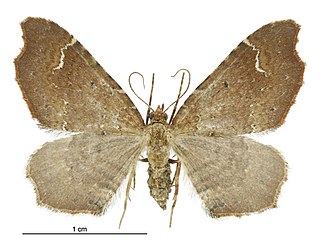
Asaphodes camelias is a species of moth in the family Geometridae. It is endemic to New Zealand, has been observed in both the North and South Islands and inhabits native forest. The adults of this species are on the wing from February to May and July to September.
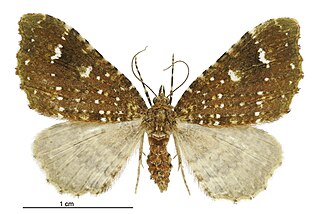
Asaphodes limonodes is a species of moth in the family Geometridae. It is endemic to New Zealand and is found in both the North and South Islands. This species inhabits damp native forest. Adults are on the wing from November until March.

Tingena aphrontis is a species of moth in the family Oecophoridae. It is endemic to New Zealand and has been collected at altitudes between 3000 - 5000 ft at Arthur's Pass and Mount Arthur. The species lives in open alpine habitat amongst alpine vegetation. Adults of the species are on the wing in January.

Tingena berenice is a species of moth in the family Oecophoridae. It is endemic to New Zealand and has been found in the North and South Islands. It is a brightly coloured species which is on the wing in November. Its preferred habitat is mixed beech forest.
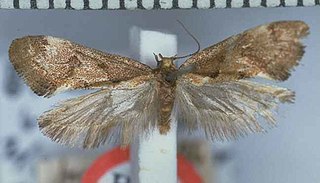
Tingena brachyacma is a species of moth in the family Oecophoridae. It is endemic to New Zealand and has been found in the south of the South Island. This species inhabits open swamps, native forest and scrubland and has been collected amongst Leptospermum. The adults of the species are on the wing in November and December.

Tingena chloradelpha is a species of moth in the family Oecophoridae. It is endemic to New Zealand and can be found in the North and South Islands. The larvae live underground forming silken tubes from which it feeds. It overwinters in these tubes and then pupates enclosed in a weak pale white silken cocoon. The adults of this species is variable in appearance both in the depth of colour as well as in its discal spots which may in some specimens be lacking. The adults are on the wing from October until the end of December and can be found inhabiting domestic gardens as well as cultivated land. They have been seen resting on window frames and can be found inside houses.

Tingena chloritis is a species of moth in the family Oecophoridae. It is endemic to New Zealand and has been found in the South Island. Larvae of this species feed on leaf litter. The adults of this species are light flyers and are attracted to light.
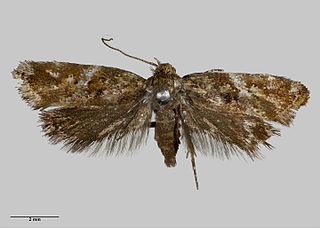
Tingena eumenopa is a species of moth in the family Oecophoridae. It is endemic to New Zealand and found in the North and South Islands. The adults have been found amongst tree ferns and are on the wing in December.

Tingena horaea is a species of moth in the family Oecophoridae. It is endemic to New Zealand and have been observed in both the North and South Islands. The adults are on the wing in January.

Tingena oxyina is a species of moth in the family Oecophoridae. It is endemic to New Zealand and has been observed in the Otago region. This species inhabits native beech forest at altitudes of between 1000 - 3000 ft. Adults of this species are on the wing in January.
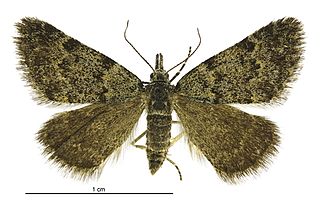
Dichromodes cynica is a moth of the family Geometridae. It was first described by Edward Meyrick in 1911. D. cynica is endemic to New Zealand and is found only around Christchurch and Banks Peninsular. The larvae of D. cynica are cryptic in appearance and feed on lichens growing on dry sunny rock faces. Adults are on the wing from September to February. D. cynica are active during the day and are rapid fliers.
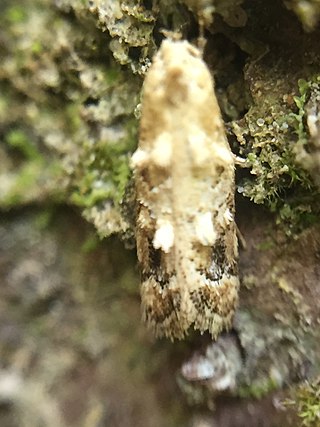
Trachypepla aspidephora is a species of moth in the family Oecophoridae. It is endemic to New Zealand and has been observed in the North and South Islands. Adults are on the wing from November to March and are attracted to light. The moths can be found resting on tree trunks where their colouration imitates lichens.






















